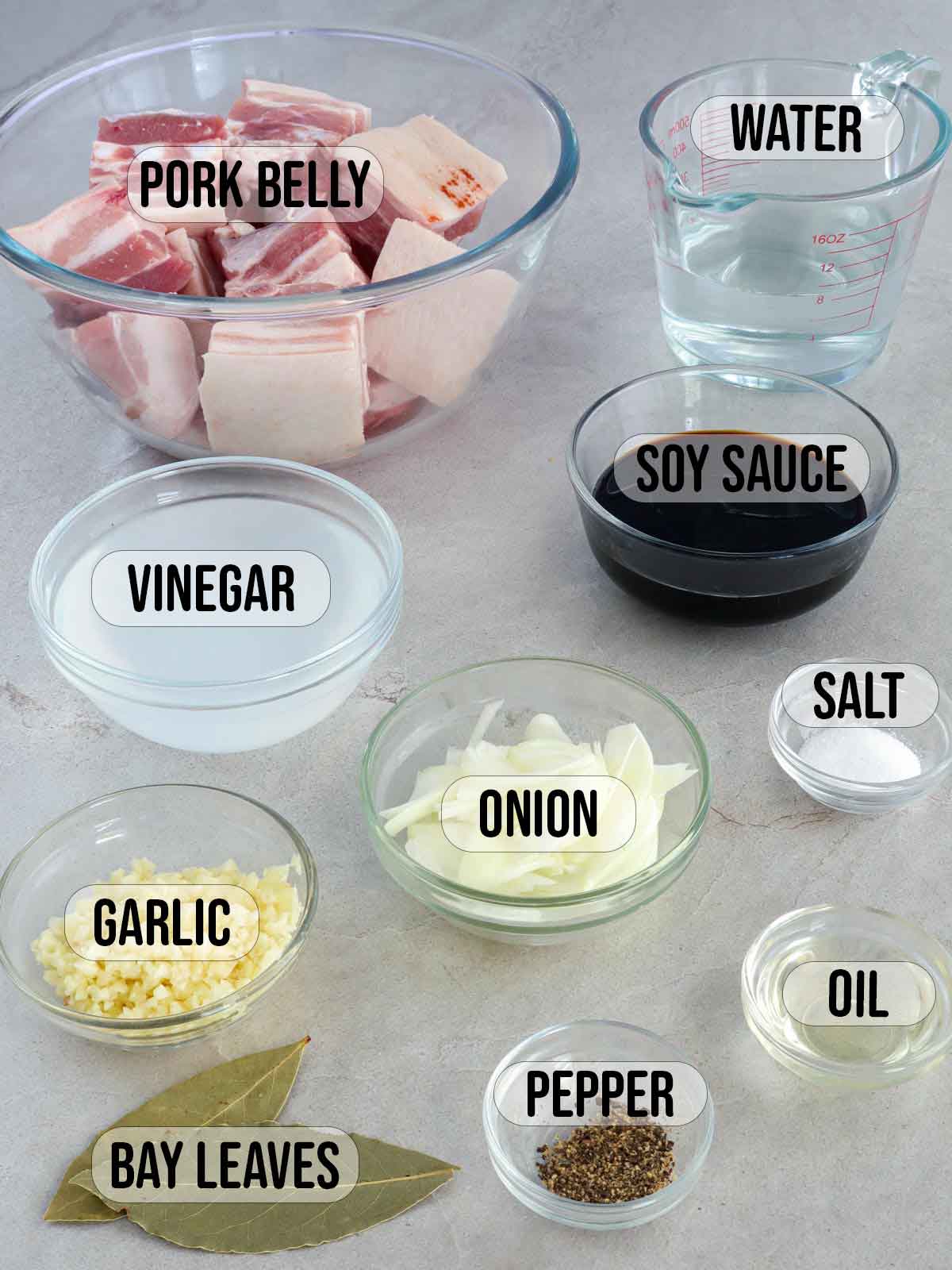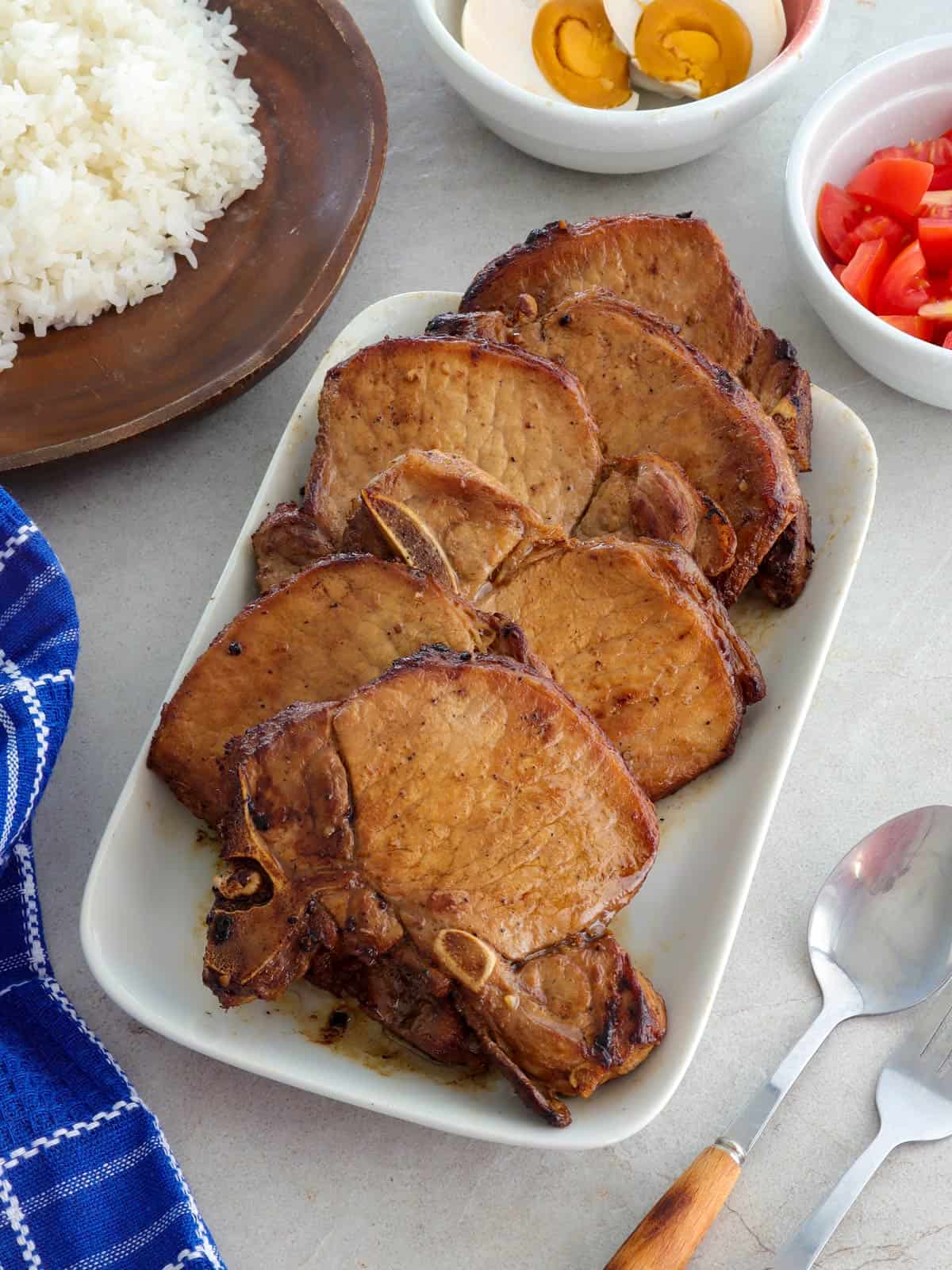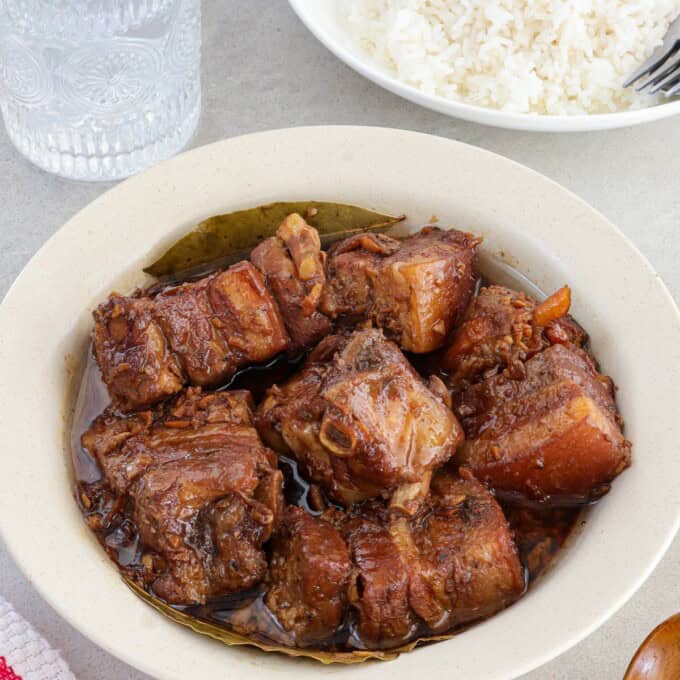Pork Adobo is made with succulent pork belly braised in vinegar, soy sauce, garlic, and onions. A delicious balance of salty and savory, this hearty stew is the Philippines' national dish for a good reason!

The Filipino adobo is a cooking process or technique in which meat, seafood, or indigenous vegetables are braised in a mixture of vinegar and aromatics such as garlic, onions, peppercorns, and bay leaves.
The many ways adobo is prepared are as diverse as the islands and dialects in the Philippines. Adobong pula with atsuete, Adobo sa gata, and Pineapple Pork Adobo are just a few versions of this classic Filipino national dish.
Some like the hearty stew with more sauce, while others prefer it simmered dry. Others like it slightly tangy, while some prefer it on the sweet side. This recipe is how I like mine, with beautifully seared pork and a rich and thick sauce to spoon over mounds of rice.
More adobo recipes to try
Ingredient notes

- Pork- I prefer to use pork belly in my adobo because I like its melt-in-your-mouth tenderness, but you can substitute pork shoulder, which, although a leaner cut, has enough ribbons of fat to bring equally delicious results. Other cuts, such as pork chops, legs, hocks, and ribs, are also good options for slow cooking.
- Oil- for sauteing and browning
- Sauce- a classic combination of tangy vinegar and savory soy sauce; water for tenderizing the meat.
- Aromatics- garlic, onion, bay leaves, and peppercorns enhance flavor.
- Seasonings- adjust taste with salt and pepper
Pork Adobo cooking steps

- Marinate- Cut the meat into uniform pieces to ensure even cooking. Combine with onions, garlic, bay leaves, salt, and pepper in a bowl. Marinate in the refrigerator for about 30 minutes.
- Brown the pork - Heat oil in a wide, heavy-bottomed skillet over medium heat. Add the meat mixture and cook, turning occasionally, until the pork is lightly browned. Do not overcrowd the pan when browning the pork so it gets a good sear and does not steam. Use a wide pan or cook in batches if necessary. Properly searing the meat before adding the braising liquid is an important step, as it gives the dish a delicious color and incredible depth of flavor.
- Add vinegar and allow it to boil, uncovered, without stirring to cook off the strong acid taste.
- Cook- Add soy sauce and water and stir to combine. Bring to a boil. Lower the heat, cover, and simmer until the meat is fork-tender and the sauce is reduced. Season with salt and pepper to taste.
Cooking tips
- Potatoes and hard-boiled eggs are a delicious way to extend servings. To help the potatoes from falling apart, pan-fry the cut potatoes first before adding them to the stew.
- If you want to season the dish with more salt than the recipe calls for, I suggest adding it during the last few minutes of cooking to gauge taste correctly. The flavor of the dish will concentrate as the sauce reduces.
Serving suggestions

- Adobong baboy is best enjoyed with piping hot steamed rice for lunch or dinner. It's common to find it on breakfast menus, such as an adosilog meal (adobo, garlic fried rice, and fried egg).
- While it is mainly served as a viand, adobo meat is also used as a filling for bread, such as siopao or pandesal.
Storing leftovers
The adobo cooking process was initially a way to preserve food. Pre-colonial Filipinos prepared meat and seafood in vinegar and salt to prolong shelf life. It's a great make-ahead dish that tastes better after a day or two when the flavors have melded.
- Cool completely before transferring to a container with a tight-fitting lid. Refrigerate for up to 3 days or freeze for up to 2 months.
- Reheat in a wide pan over low heat to an internal temperature of 165 F or in the microwave at 2 to 3-minute intervals until completely heated.
- Leftovers can also be turned into delicious fried rice. Shred the cooked meat and toss with day-old steamed rice in a hot pan along with a few tablespoons of the sauce.
More pork recipes
Ingredients
- 2 pounds pork belly, cut into 2-inch cubes
- 1 onion, peeled and sliced thinly
- 1 head garlic, peeled and minced
- 2 bay leaves
- 1 teaspoon salt
- ½ teaspoon pepper
- 1 tablespoon oil
- 1 cup vinegar
- ½ cup soy sauce
- 1 cup water
Instructions
- In a bowl, combine pork, onions, garlic, bay leaves, salt, and pepper. Place in the refrigerator and marinate for about 30 minutes.
- In a wide, heavy-bottomed skillet over medium heat, heat oil. Add meat mixture and cook, turning occasionally, until pork is lightly browned.
- Add vinegar and allow to boil, uncovered and without stirring, for about 3 to 5 minutes.
- Add soy sauce and water and stir to combine. Allow to a boil for another 3 to 5 minutes.
- Lower heat, cover, and simmer for about 40 to 50 minutes or until meat is fork-tender and sauce is reduced.
- Season with salt and pepper to taste. Serve hot.
Notes
- Cook off the strong vinegar flavor by allowing it to boil uncovered and without stirring for a good few minutes before adding the soy sauce and water.
- If you want to season the dish with more salt than called for in the recipe, I suggest adding it during the last few minutes of cooking to correctly gauge taste. The flavor of the dish will concentrate as the sauce reduces.
Nutrition Information
“This website provides approximate nutrition information for convenience and as a courtesy only. Nutrition data is gathered primarily from the USDA Food Composition Database, whenever available, or otherwise other online calculators.”








Sidney says
This recipe came pretty good for the first time making it. Needs some adjustments though. And I noticed you mentioned that you use Datu but it's not stated in the recipe when it should. Compared to Datu, distilled vinegar is way too strong. That's why you are getting many negative comments.
Lalaine says
Thanks for the tip, Sidney. I agree, distilled vinegar makes an adequate substitute when there's no other type of vinegar available but Datu Puti brings the best flavor.
Munica Green says
Made this receipe and it came out delicious! Thank you!
Lalaine says
Thanks for the feedback, I am glad you enjoyed the recipe 🙂
Munica says
I would have shared a photo but my family enjoyed so much no chance. Thanks and I hope to go too more of your delicious food.
Lalaine says
You can tag me on Instagram or on Facebook, if you like. Just hashtag #kawalingpinoy and I'll find it 🙂
Connie Lum says
Can you instant pot this recipe? If so any instructions?
Lalaine says
I actually have an Instant Pot recipe on my other blog 🙂 https://therecipepot.com/instant-pot-pork-adobo/
Andrea says
Gave your recipe a try and it did not disappoint (my 10 year olds become quite the picky guy). I substituted thick boneless pork chop since I couldn’t find decent pork belly at my local grocery store. I love how simple and thorough your recipe was. Thanks so much 🙂 !
Lalaine says
Thank you, Andrea. It's a struggle to feed kids sometimes. My daughter at that age won't eat anything other than hamburger and pizza. 🙂
Courtney says
I made this tonight I didn't use a full cup of vinegar, more like 6oz. I had not boiled off the vinegar before when attempting other recipes, so that's why I cut the vinegar back a tad for yours. However, boiling off the vinegar made a huge difference. So thank you for that step. This is by far my favorite pork belly recipe. 😉
Lalaine says
Thanks for the feedback, Courtney! Yes, boiling the vinegar makes a big difference as the step really tames the strong acid taste. 🙂
Nicka Tan says
Hi Lalaine!
I am excited to try your pork adobo recipe!
Can I ask a 'lil favor from you?
Can you give me the exact amount of ingredients for a 3 kilos pork meat?
I'll be cooking for a bunch of people for a birthday celebration.
Hoping for your immediate response.
Thank you so much!
Sincerely,
Nicka Tan 😊
Noel says
Tried this last night, followed the recipe, but we cut the vinegar to 1/2 cup and soy sauce to 1/4 cup. Saltiness is ok but its still sour to our taste.
Lalaine says
I am sorry the recipe didn't work well for you. May I ask please if the vinegar was allowed to boil? This step really makes a big difference in the taste. Where the liquids properly measured? 1/2 cup which is 4 ounces is not a lot considering the amount of meat so I am not sure why it would too acidic.
Will says
I have made too many times to count. My recipe of course which is pretty similar. I tweak little things here and there to see how it changes and the 1 thing that is ALWAYS constant is the vinegar. Go to an Asian market and use DATU PUTI vinegar and you cant mess this up!
Silver says
Is it supposed to look like a soup cause mine is lol i followed the recipe but mine isnt dry in the end. It swimming with liquid.
Lalaine says
I am sorry to hear that. Were the ingredients measured accurately? The recipe calls for 2 1/2 cups or 20 ounces liquid in total, there shouldn't be a lot left after cooking the meat for about an hour. In fact, sometimes I have to add more water as it dries out before the pork is fully cooked and tender.
Kaitlyn says
I've made it couple of times now. 1/2 cup of water and a mostly covered pan works a treat for me.
Em says
I followed this recipe exactly, but the adobo turned out extremely sour and was awful! Wouldn’t try this recipe again. Sorry.
Lalaine says
Hello Em,
I am sorry the recipe didn't work well for you. I've made this pork adobo many times using the same measurements. May I ask if you used 8 ounces of vinegar and allowed it to boil uncovered? This is an important step as it cooks off the strong acid taste.
Emily says
I followed the recipe exactly
Lalaine says
Hi Emily,
I am sorry you were disappointed with the recipe. As I said previously, I make mine exactly as written and it has the right balance of flavors for me so I am not sure what went wrong. 8 ounces of vinegar (1 cup) is not really a lot considering the amount of meat. It shouldn't have too sour of a taste when it's allowed to boil uncovered and without stirring as that would cook of the acid taste.
Matthew says
Hi Lalaine. Your recipes are Wonderful and a joy to learn from, so Thank you very much! To Emily: Try adding the Vinegar at the end during the last 10 minutes of cooking instead.
Lalaine says
Thanks for the tip, Matthew! I am glad you find the recipes here helpful.
Dzezza Magne Gamino says
OMG! I did this last night and it was good! My husband loved it! And my friend who is expert in cooking food really liked it! Ano daw gnawa ko! Hahaha thank you so much po for this! It was very easy to follow at patok na patok xa! Ang galing, ang dali at napakasarap! I added boiled eggs din po and its really yummy! Thank you very much po 😉
Lalaine Manalo says
Hi DM! Glad it turned out great. We aim to provide easy to follow recipes. Thank you.
Tanya Regala says
hi thank for sharing that awesome ingredients of pork adobo i really like it.
Steph says
I made this tonight with pork shoulder instead of the pork belly stared in the recipe and it was very tender and tasty. I left everything simmering for about an hour and 20 minutes and the meat was very tender. I will definitely making this regularly. Thank you!
Lalaine says
Thank you, Steph!
Di says
Im about to try your recipe po and napansin ko on the 1st step it says marinate with garlic onion pepper and salt so no liquid included po on the marinating process? Thanks
Lalaine says
Hi DJ,
Yes, no liquids. Just marinate with the seasonings and aromatics 🙂
Nora says
Hi question can you use datu puti soy sauce sarap linamnam for pork adobo?
Lalaine says
Hello Nora,
I know Datu Puti soy sauce but I've never heard the sarap linamnam. I live in California so I am not familiar with new products in the market. Is that a flavored soy sauce?
Kim says
Hi Lalaine, Do you use distilled vinegar or Apple cider vinegar?
Lalaine says
Hello Kim,
I usually use Filipino brand vinegar but if I don't have any on hand, distilled vinegar works fine. 🙂
Tamika says
My partner is a Filipino born and raised. He introduced me to ‘Adobo’. I’ve been in love since! Best thing I’ve ever eaten.
I use datu vinegar.
Lalaine says
Yes, adobo is life 🙂 I use Datu Puti also, it has a mellower taste than regular distilled vinegar in my opinion. I hope you try the recipes here as well. Happy cooking!
Coleen says
Distilled